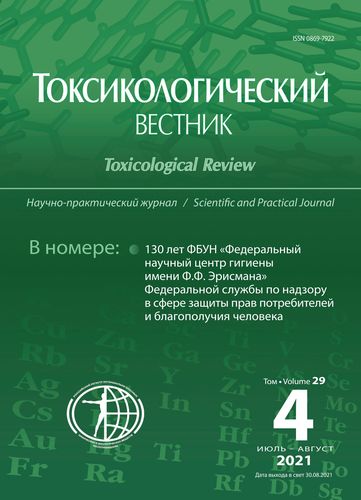On the issue of nongenotoxic cancerogenes
- 作者: Revazova Y.A.1, Ilyushina N.A.1
-
隶属关系:
- Federal Budgetary Establishment of Science “Federal Scientific Center of Hygiene named after F.F. Erisman” of the Federal Service for Surveillance on Consumer Rights Protection and Human Wellbeing
- 期: 编号 4 (2021)
- 页面: 51-55
- 栏目: Discussion
- ##submission.datePublished##: 03.09.2021
- URL: https://vestnik.nvsu.ru/0869-7922/article/view/641346
- DOI: https://doi.org/10.36946/0869-7922-2021-29-4-51-55
- ID: 641346
如何引用文章
全文:
详细
Introduction. Chemical, physical or biological factors that can cause the formation and expansion of cancer cells are diverse in terms of both activity and mechanisms of action, which leads to the complexity of assessing the risk of developing malignant neoplasms.
The aim. Discussion of the carcinogene classification based on their ability to interact with cell DNA and possible mechanisms of genetic control of carcinogenesis processes induced by non-genotoxic carcinogens.
The article draws attention to some controversial points related to the attribution of factors affecting an organism to genotoxic or non-genotoxic carcinogens. The terminology used in the literature to describe genotoxic (mutagenic) and carcinogenic factors is presented. The mechanisms of action of non-genotoxic carcinogens are discussed. The important role of experts determining the hazard to public health of factors with potential genotoxicity and carcinogenicity is noted.
Conclusion. Non-genotoxic carcinogens are capable of inducing malignant growth through mechanisms not associated with direct damage to genetic structures in the cell. However, the realization of carcinogenic effects caused by such factors is determined by various mechanisms of genetic control.
作者简介
Yulia Revazova
Federal Budgetary Establishment of Science “Federal Scientific Center of Hygiene named after F.F. Erisman” of the Federal Service for Surveillance on Consumer Rights Protection and Human Wellbeing
编辑信件的主要联系方式.
Email: noemail@neicon.ru
ORCID iD: 0000-0001-5067-5469
Scopus Author ID: 6602245454
俄罗斯联邦Nataliya Ilyushina
Federal Budgetary Establishment of Science “Federal Scientific Center of Hygiene named after F.F. Erisman” of the Federal Service for Surveillance on Consumer Rights Protection and Human Wellbeing
Email: iliushinana@fferisman.ru
ORCID iD: 0000-0001-9122-9465
Doctor of Biological Science, Head of the department of genetic toxicology, FBES “Federal Scientific Center of Hygiene named after F.F. Erisman” of the Federal Service for Surveillance on Consumer Rights Protection and Human Wellbeing, 141014, Mytishchi, Moscow region, Russian Federation.
e-mail: iliushinana@fferisman.ru
Scopus Author ID: 6603049459
俄罗斯联邦参考
- Gorbunova V.N., Imyanitov E.N. Genetics and carcinogenesis. Methodological manual for students of medical universities [Genetika i kancerogenez. Metodicheskoe posobie dlya studentov medicinskikh vuzov]. Izd. SP6GPM. 2007; 30. (In Russian)
- Zaridze D.G. Carcinogenesis [Kancerogenez]. Moscow: Medicine; 2004, 576. (In Russian)
- List of classifications. IARC Monographs on the identifications of Carcinogenic Hazards to Humans. 2018; 1-123: 4-17.
- Melnick R.L., Kohn M.C., Portier C.J. Implications for risk assessment of suggested nongenotoxic mechanisms of chemical carcinogenesis. Environ. Health Perspect. 2016; 104 (Suppl 1): 123-34.
- Williams G.M. Mechanisms of chemical carcinogenesis and application to human cancer risk assessment. Toxicology. 2001; 166: 3-10.
- Hernández L.G., Steeg H., Luijten M., Benthem J. Mechanisms of non-genotoxic carcinogens and importance of a weight of evidence approach. Mutation Research/Reviews in Mutation Research. 2009; 682(2-3): 94-109.
- Zakiyan S.M., Vlasov V.V., Dementieva E.V., eds. Epigenetics [Ehpigenetika]. Novosibirsk: SB RAS. 2012; 592 p. (In Russian)
- Szekvolgyi L., Imre L., Minh D. X., Hegedus E., Basco Z., Szabo G. Flow cytometric and laser scanning microscopic approaches in epigenetics research. Methods Mol/Biol. 2009; 567: 99–111.
- Diamanti-Kandarakis E., Bourguignon J-P., Giudice L., Hauser R., Prins G.S., Soto A.M., Zoeller R.T., Gore A.C. Endocrine-disrupting chemicals: An endocrine society scientific statement. Endocrine Reviews. 2009; 30 (4): 293–342.
- Dyuzhikova N.A., Daev E.V. Genome and stress response in animals and humans. Ehkologicheskaya genetika. 2018; 16 (1): 4-26. (In Russian)
- Ilyushina N.A., Revazova Y.A. Role of the expert community in the evaluation of the mutagenicity and carcinogenicity of pesticides. Toksikologicheskiy vestnik (Toxicological Review). 2019; (4): 48-53. (In Russian)
- Turusov B.C., Rakitsky V.N. Classification of pesticides according to the degree of carcinogenic hazard to humans. Voprosy onkologii. 1997; 43(3): 299-303. (In Russian)
- Turusov B.C., Belitsky G.A., Pylev L.N., Koblyakov V.A. Chemical carcinogenesis. In: Zaridze D.G., ed. Carcinogenesis [Kancerogenez]. Moscow: Medicine; 2004: 204-25. (In Russian)
补充文件







